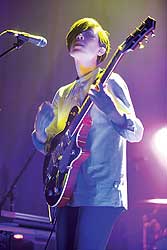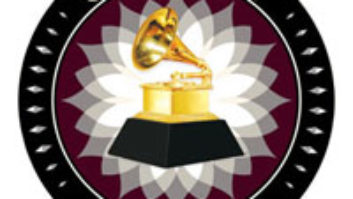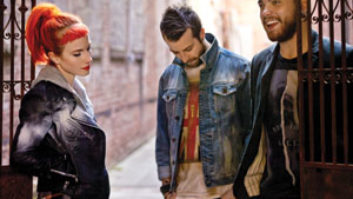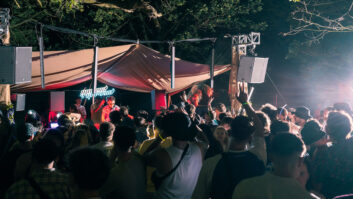
Sara Quin
Photos: Steve Jennings
Singing/songwriting sisters Tegan and Sara (say that five times fast!) are out in support of their latest effort, Sainthood, with fellow musicians Shaun Huberts (bass), Edward “Ted” Gowans (guitar/keys) and Johnny “Five” Andrews (drums); they will open up for Paramore this summer. The tour is carrying full production except for P.A. While front-of-house engineer Doug McKendrick has seen a bevy of P.A.s on this tour, this doesn’t phase him as he has full confidence in supplier Rob Nevalinen at Gear Force (Vancouver). As the engineer says, “If anything breaks, he’s right on top of it.” Mix caught up with the tour at the Fox Theater (Oakland, Calif.).
Front-of-house engineer Doug McKendrick has been using Digidesign consoles for the past five years. He relies heavily on the VENUE’s snapshots, and with the board’s Event List functions, “I can really do anything I want,” he says. “Tegan and Sara have two vocal positions each, so I have a snapshot that repatches their vocal mic, depending on their position. I only have to deal with two vocal channels and I only need to carry two Distressors instead of four.
As for plug-ins, McKendrick opts for the Crane Song Phoenix, using that on nearly every input. “I love the extra dimension it adds to my mix,” he explains. For output parametrics, he uses the Sony Oxford EQ: “It’s such a transparent EQ and really essential to the way I tune systems. A useful tool for their vocals is the McDSP MC4000 multiband compressor,” he continues. “With this gig, vocal clarity is absolutely essential. With the MC4000, I can get the vocal way out front and clear without it getting too bright. I run that first in the chain to subtly smooth things out and then into my Distressors for overall compression.

Tegan Quin
“I clock the console with an Apogee Big Ben. I have two Distressors that I use as the overall compression on their vocals after some subtle multiband compression; it helps
me get every nuance out of their vocals.
“The goal has always been to re-create the album, sonically, live. Ted Gowans, our guitar and keyboard player, actually went through the album tracks and pulled each keyboard sound and sampled them for the live show. Most of the sounds on the record were analog synths going through guitar pedals and amps.”
Edward “Ted” Gowans’ guitar food pedals include Boss tuner, Zvex Super Hard On, Fulltone Fulldrive 2, vintage Chorus and a vintage delay. His keyboard is a Nord Wave synthesizer.
This is Tegan Quin’s pedal board. Upper row: Boss NS-2, OD-3, LS-2, and TU-2. Lower row: Ibanez TS-9, Boss CE-2, MXR MicroAmp, Boss DD5 and a Zvex Fuzz Factory.
Bassist Shaun uses an Ampeg SVT Classic rig, SVT-CL bass head with an SVT- 810E bass enclosure.
According to guitar/bass/drum/keys tech/stage manager Allen Hannigan, Tegan Quin uses an Acme Lulu amplifier played through a Dr. Z closed-back 1/12-inch speaker cabinet miked with a Heil PR30.
Johnny “Five” Andrews’ kit is miked with a Shure MS91 and Yamaha Subkick on the kick drum; Shure Beta 57 for snare top; Neumann KM184 on snare bottom and hi-hat; Shure Beta 56 on rack tom; Beta 52 on floor tom; and two Audio-Technica AT4033s for overheads. “We put D-Drum triggers on the toms to open the gates—really cleans things up and eliminates the gate chatter,” Kilburn says.
According to guitar/keyboard tech Sunny Dhak, Sara Quinn’s pedal chain comprises a Boss output selector; Liele input selector; Pro D2 stereo direct box; and Boss overdrive, chorus, reverb, delay and tuner out to amp. “Also included are two DIs that allow her to have the [Roland] Juno-G workstation keyboard running through her pedals/amp,” Dhak adds. “There is also a dry DI signal so Doug [McKendrick] can blend the two sounds.”
Monitor engineer Chandy Kilburn is mixing on a Digidesign VENUE SC48 and taking advantage of the board’s onboard plug-ins, including the Fairchild 660s on vocals, acoustic guitars and bass. “I find they help make the vocals stick out more in the ear mixes,” Kilburn says. “I’m also running McDSP G console comp/EQs on the drum channels, as well as a bus compressor on the outputs of all the ears. I’m also using lots of Digidesign’s Revibe and Reverb Ones. All my processing is done inside the console aside from the Dolby Lake controller for the monitor EQs.”
Wedges are Adamson M-15s powered by Lab.gruppen PLM 10000s. Kilburn has four monitors on four mixes for Tegan Quin, three mixes for guitars and one mix for keyboards, as well as a vocal wedge in front of her and a stereo pair on the outside. The rest of the band is on in-ears: Sennheiser G2 transmitters with a Shure PA821 antenna combiner and a helical antenna. Sara Quin, Gowans and Huberts wear Westone ES2s; Andrews takes Sensaphonics. “I also carry an IW1800 RF spectrum analyzer to ensure clean RF,” Kilburn adds.





